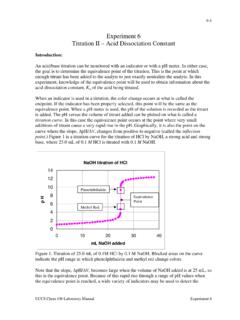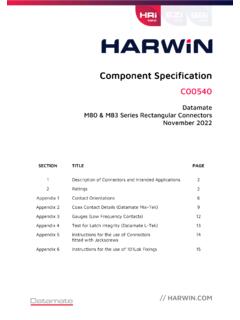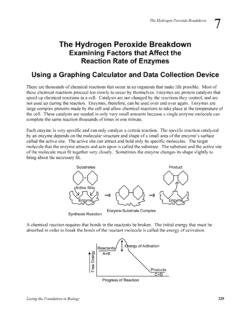Transcription of Experiment 6 Coffee-cup Calorimetry
1 6-1 Experiment 6 Coffee-cup Calorimetry Introduction: Chemical reactions involve the release or consumption of energy, usually in the form of heat. Heat is measured in the energy units, Joules (J), defined as 1 kg m2/s2. Another common heat unit is the calorie (cal). It is defined as the amount of heat required to raise the temperature of one gram of water by one degree Celsius, at a temperature of 4 C. One calorie is equal to J. J cal 1 and smkg 1 J 122= = Reactions that give off energy as heat are called exothermic heat exits the system, while reactions that absorb heat from their surroundings as they occur are called endothermic heat goes into the reaction system. Calorimetry is the study of heat transferred in a chemical reaction, and a calorimeter is the tool used to measure this heat. It is an insulated apparatus containing a liquid reservoir in which the reaction occurs. The reservoir s heat capacity relates the temperature change, T, in the reservoir due to heat transferred into or out of it, qres, as shown in Equation (1).
2 Qres = (Heat capacity) T (1) Heat capacity therefore has units of J/ C or J/K. Note that either oC or K can be used for the change in temperature, since the difference in a degree is the same for both scales. Thus if the heat capacity of the reservoir is known, qres can be calculated from the difference in the temperature of the reservoir measured before (Tinitial) and after (Tfinal) the reaction occurs. T = Tfinal - Tinitial (2) The specific heat capacity (or just specific heat) is the heat capacity per gram of the reservoir liquid and is given the symbol, C. Thus the units for C are, J/g C or J/g K. Since the heat capacity of a given mass of liquid can be written as C (mass), Equation (1) becomes: qres = C mass T (3) The specific heat of water has the relatively high value of J/g K. The reservoir in a calorimeter used to study reactions occurring in water will be de-ionized water or a dilute aqueous solution, which has virtually the same value of C.
3 A simple calorimeter can be made from two Styrofoam coffee cups, with one inside the other, and an insulating cover. Placing the cups in a 400 mL empty beaker to elevate the calorimeter off the counter top increases insulation from the outside environment. The UCCS Chem 103 Laboratory Manual Experiment 6 6-2 Vernier Temperature Probe is fitted through a rubber stopper and then inside a small hole at the top to measure the temperature of the reservoir. Figure 1 The inner cup is filled with a known volume of liquid, which serves as the reservoir. This volume is converted into mass by assuming that the reservoirs are either dilute aqueous solutions or pure DI water with a density of g/mL. For example, OH g mLg mL Knowing the mass and specific heat of the reservoir, and the measured temperature change, the heat transferred in to or out of the reservoir can be calculated using Equation (3). Note that the heat transferred by the reaction will be opposite in sign to the heat transferred into or out of the calorimeter reservoir.
4 Heat given off during a reaction is absorbed by the reservoir, and heat absorbed in a reaction is given off by the reservoir. The heat of any chemical reaction measured with the calorimeter is therefore: qrxn = qres (4) In this Experiment three processes involving heat transfer will be studied. Heat of Neutralization The transfer of heat that results from an acid/base neutralization reaction carried out at constant pressure is called the enthalpy of neutralization, Hneutralization, and is expressed in units of kJ/mol. The reaction to be studied is: NaOH(aq) + HCl(aq) H2O(l) + NaCl(aq) As with any chemical reaction, the extent of the reaction is dependent on the amount of limiting reactant present. Given the moles of limiting reactant undergoing reaction and the UCCS Chem 103 Laboratory Manual Experiment 6 6-3 measured heat of the reaction, Hneutralization can be determined as shown below, keeping in mind that qrxn = qres. (5) reacted moles rxntionneutralizaqH= Enthalpy of Solution of Salts When a salt dissolves in water at constant pressure, there is a transfer of heat associated with the reaction called the enthalpy of solution, Hsolution.
5 It is expressed in units of kJ/mol of salt. (6) salt of moles rxnsolutionqH= The solution process can be written as follows: NH4NO3(s) NH4+(aq) + NO3 (aq) Heat may be given off or absorbed by the salt as it dissolves as ions in water. Specific Heat of a Metal You will find the specific heat of a metal by equating the heat lost by the metal (at high temperature) to the heat gained by the water reservoir at a lower temperature when they are mixed in the calorimeter. The metal must first be heated and its temperature measured, Tinitial (metal). The temperature of the water reservoir is measured prior to, Tinitial (water), and after, Tfinal (water), adding the solid to it. The heat transferred to the water is the opposite sign of the heat lost by the metal. qmetal = qwater The formula for q given by Equation (3) can then be substituted on each side of the equation to give: Cmetal mass metal Tmetal = [ Cwater masswater T water ] (7) Rearranging this equation to solve for the specific heat of the metal, results in an experimentally determined specific heat of the metal that can be compared to the actual value of the specific heat of the metal.
6 (8) ))((mass))()(mass(- metalmetalwaterwaterwatermetalTTCC = UCCS Chem 103 Laboratory Manual Experiment 6 6-4 Pre-Lab Notebook: Provide a title, purpose, list of chemical reactions (neutralization and both salt dissolutions), procedure, and table of reagents (as shown below) in your notebook before coming to lab. Reagents FM Specific heat (J/g K) Hazards NaOH No entry HCl No entry MgSO4 No entry No entryNH4NO3 No entry No entryCu No entryCr No entryPb No entry Equipment: Vernier LabPro mL Graduated cylinder TI -84 calculator 400 mL Beaker, with boiling chips Vernier Temperature Probe Large test tube coffee cup calorimeter Hot plate 100 mL Beaker Test tube holder In-Lab Experimental Procedure: Note: Work in pairs.
7 Part A: Heat of Neutralization 1. Set up the calorimeter in a 400-mL beaker as shown in Figure 1. Measure 50 mL of M NaOH using a graduated cylinder, add it to the calorimeter and record the exact volume and molarity of the solution (as indicated on the bottle containing the NaOH solution) in your laboratory notebook. 2. Measure 50 mL of M HCl using a graduated cylinder and place it in a 100 mL beaker, NOT in the calorimeter. Record the exact volume and molarity of this solution. Note that the molarity and volumes of both reactants must be known in order to determine which is the limiting reactant. 3. Set up the Vernier equipment as directed in the first section of the Vernier tutorial. Connect the temperature probe to channel 1. Use the Vernier temperature probe to measure and record the temperature of both solutions in your notebook. First set up the data collection mode. Select 1:SETUP from the main screen. To select MODE, press or until the cursor is to the left of MODE and press ENTER.
8 Select TIME GRAPH from the SELECT MODE menu. Select CHANGE TIME SETTINGS. Type 1 for the time between samples in seconds, and press ENTER. Type 10 for the number of samples, and press ENTER. Select OK twice to return to the Main screen. Insert the temperature probe into the solution and select START to begin the 10 second measurement. A few seconds after the end of the measurement, the temperature curve will appear. Scanning the curve allows you to determine that the temperature of the solution is constant and UCCS Chem 103 Laboratory Manual Experiment 6 6-5 gives you a temperature value (the value at the end of the scan) with 3 places past the decimal point to record in your notebook. Press ENTER and select 2:START to repeat the process for the other solution. You will use the average temperature of the two solutions as the initial temperature of the reservoir of the calorimeter, Tinitial. 4. Select 1:SETUP from the main screen. Select MODE and then select TIME GRAPH. Select CHANGE TIME SETTINGS.
9 Type 3 for the time between samples in seconds, and press ENTER. Type 60 for the number of samples, and press ENTER. Select 1:OK twice to return to the Main screen. 5. Slide the temperature probe through the holes of the stopper and insulating cover gently, making sure not to poke holes in the Styrofoam and keeping the tip of the probe about 3 cm from the bottom of the cup. 6. Hit 2:START and wait 15 seconds before mixing the reagents. Then, keeping the insulating cover open at a slant with the temperature probe still in contact with the NaOH solution in the calorimeter add the HCl solution to the calorimeter. Immediately secure the insulating cover and carefully (so as not to cause spillage!) swirl the calorimeter for about 30 seconds to mix the solutions. 7. Listen for the LabPro beep to signify the end of data collection. After the temperature curve appears, scan the curve to determine and record the final temperature, Tfinal, of the reservoir. This is the temperature reading which corresponds to the largest change from the initial temperature.
10 8. Dispose of the solution down the sink and rinse the calorimeter with tap water and then DI water. Press ENTER to return to the Datamate main screen. NOTE: The net ionic equation for this neutralization reaction is: H+ + OH H2O(l). In the Post-Lab, you will calculate the Hneutralization in kJ/mol for this net ionic reaction from the Hfo data in the appendix in your textbook and compare it to your experimental value. Part B: Heat of Solution of Two Salts: NH4NO3 and MgSO4 1. Weigh out approximately 2 grams of NH4NO3 and record the exact amount. Measure 50 mL of de-ionized water and place it in the clean calorimeter, after recording the exact volume. Measure the initial temperature of the water as you did in Part A, and record this to 3 decimal places in your laboratory notebook. Note that in calculating the mass of the reservoir needed for calculation of qres, you must add the mass of the salt to the mass of water. 2. Set the Datamate program to the time graph mode with the time between samples set at 3 and number of samples set at 60.





